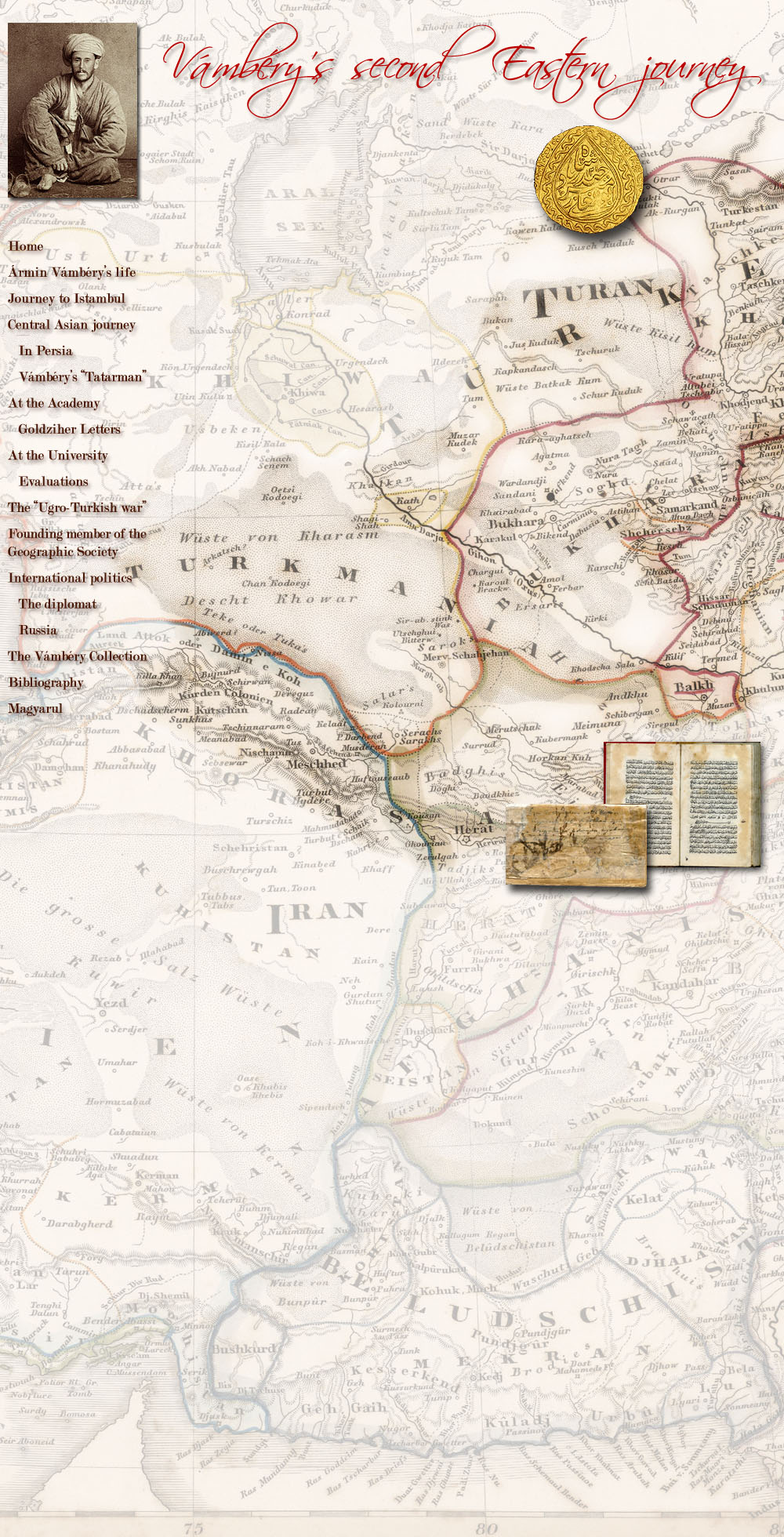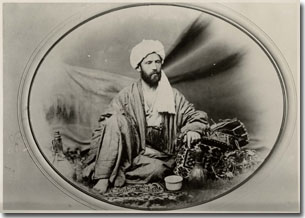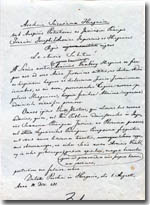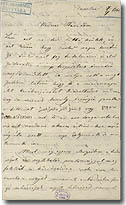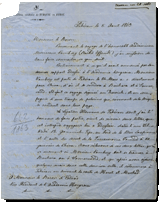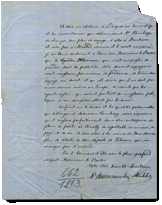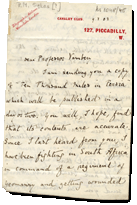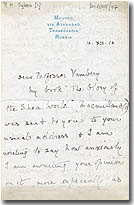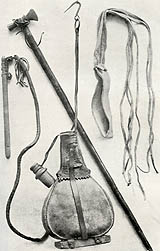

 With
the Latin letter of recommendation of the Hungarian Academy
2
and their support of 1000
forints in his pocket, at the end of 1861 he set to Istanbul, where he spent
several months with the preparations of his Eastern journey. His start was also
delayed by the cholera epidemic which broke out at the Iranian border.
3
With
the Latin letter of recommendation of the Hungarian Academy
2
and their support of 1000
forints in his pocket, at the end of 1861 he set to Istanbul, where he spent
several months with the preparations of his Eastern journey. His start was also
delayed by the cholera epidemic which broke out at the Iranian border.
3
Among other things, he took language lessons from az Uzbek from
Majman, a certain Khalmurad Mullah,
4
and in private libraries he had access to Eastern Turkic literary works and
manuscripts. He reported about his joy over these discoveries in his letters
written to his Hungarian friends, especially to József Budenz (1836-1892).
Through his Turkish acquaintances he obtained two more letters of
recommendation. These already do not recommend the Hungarian scholar Vámbéry on
his way to study the Turco-Tatar language, but Reshid efendi from
Constantinople, to the attention and benevolence of its readers, especially of
Haidar efendi, the Porta’s ambassador to Teheran.
His capital consisted essentially from his knowledge of the Turkish language,
perfected for four years, and of the successfully learned and practised
behavioral patterns. In their possession not only could he act the role of the
educated Ottoman efendi, but these also helped him in the communication with his
Muslim environment, and even in finding his ways in the Shiite society of
Persia, whose culture was different from the one he learned.
In March 1862 he left Istanbul on a steamship for Trapezunt, where
he enjoyed for a few days the hospitality of the Governor, Muhlis Emin Pasha. On
21 May 1862 he joined a caravan, continuing his way on horseback to Erzurum.
There he was received for three days by his Istanbul patron, Husein Daim Pasha.
Vámbéry, who wandered about in the role of a Sunni Turk, had to pass through the
various manifestations of the aversion of the Shiites in the Persian world,
which was for him a totally different environment in contrast to the friendly
Ottoman world. In the searing July heat he reached through the city of Khoj the
Azeri-inhabited Tabriz, and after two weeks of rest he moved forward on
donkeyback to Tehran. He expressed his new impressions by a continuous
comparison of the Turkish and Persian customs, and while on the former he gives
an image idealized in every respect, he most often condems the latter because of
their way of living and religious fanaticism. In a letter written to Budenz from
this period he bitterly reports that he “instead of Ottoman Turkish speaks in a
rough Tatar language”.
5
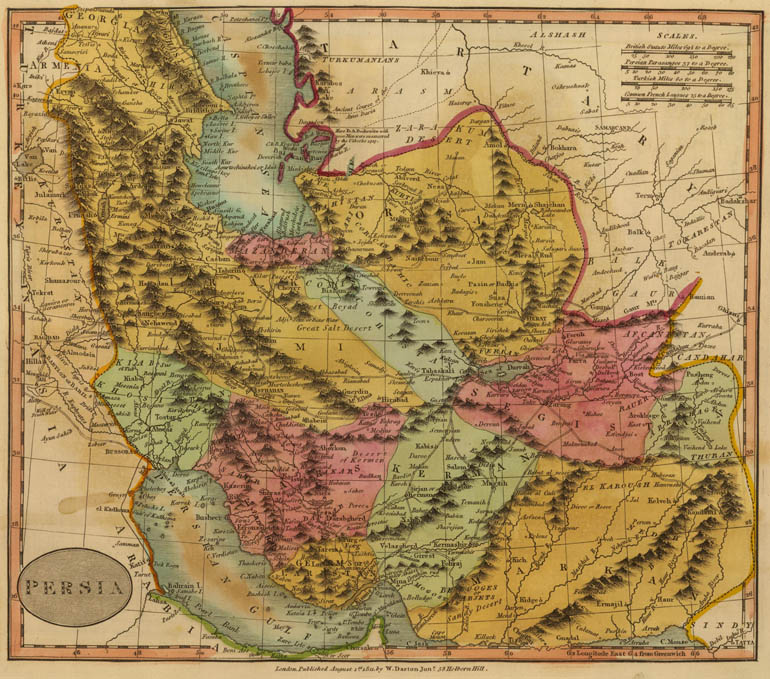
Persia. Map by W. Darton Jr., London, 1811 (full
map here, 5 MB)
Along the way, in Tabriz and Tehran, he met several Europeans,
whose companionship was a refreshing experience for him in Persia, which he
regarded as more closed, more Oriental, and thus stranger than the Ottoman
civilization. His new acquaintances, in addition to trying to dissuade him to
continue his trip, also provided useful information on the local conditions.
Among others, he met Keith Edward Abbott
(1814–1873), the former British consul in Tehran and Tabriz. He summed up
his stay in Tabriz like this: “The two weeks spent here, on the one hand
introduced me deeper into the Oriental world, but on the other hand, by the
frequent contact with westerners, revived in me the memories of European life.”
6
Vámbéry arrived in Tehran on 13 July 1862, where he immediately
went to visit Haidar efendi, who was already waiting for him. Through him he met
the French and British ambassadors, Gobineau and Sir Charles Alison. The Persian
capital had a deep, but mixed impression on Vámbéry, who provided valuable
details about the local customs.
The continuation of his way was temporarily blocked by a local
armed conflict affecting the planned Mashad–Herat route, the attack of the
Afghan Emir Dost Muhammed Khan (1793–1863) against his son-in-law and
vassal ruling Herat. As he wanted to avoid crossing the desert in the winter, he
postponed his Central Asian journey until March 1863. In order not to get too
much used to the pleasant Tehran conditions – as he wrote: “to avoid
tranquility, which may have become harmful for my future”, in September 1862 he
traveled to southern Persia, Isfahan and Shiraz, from where he returned to
Tehran only in January 1863.
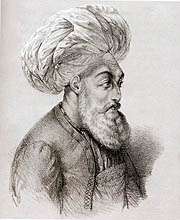 He
described his travels in Persia in a separate volume.
7
This detour of his Eastern journey led through the important Shiite pilgrimage
city of Qom – where he visited the tomb of the daughter of the seventh imam Musa
al-Kadhim, Fatima, revered as a saint –, Kashan and Isfahan to Shiraz. This
unscheduled section of his travel had few scientific results, it may be of
interest rather for his observations and vivid pictures of life, rich in detail,
published in his travelogue. Vámbéry, who in this part of Persia was already
preceded by several other European travelers, was led to this forced detour by
his personal curiosity and the will of maintaining his fitness for the long
Central Asian journey.
8
He
described his travels in Persia in a separate volume.
7
This detour of his Eastern journey led through the important Shiite pilgrimage
city of Qom – where he visited the tomb of the daughter of the seventh imam Musa
al-Kadhim, Fatima, revered as a saint –, Kashan and Isfahan to Shiraz. This
unscheduled section of his travel had few scientific results, it may be of
interest rather for his observations and vivid pictures of life, rich in detail,
published in his travelogue. Vámbéry, who in this part of Persia was already
preceded by several other European travelers, was led to this forced detour by
his personal curiosity and the will of maintaining his fitness for the long
Central Asian journey.
8
He did not have to see major atrocities as a Sunni pilgrim, but the derision and
argumentative passion of the Persians was his constant and unpleasant follower
along the way. The ancient ruins of Persepolis had a deep inpact on him. He also
used several European descriptions as a scientific complement to his
observations.
9
His enthusiasm is shown by his signature carved in
stone, written under that of his fellow compatriot, the physician and
amateur Orientalist István Maróthi István
(1799–1845), who visited the ruins in 1839.
10
He spent three months in Shiraz, the native land of the great Persian poets
Hafez (1326-1390) and Sadi (1210-1291), and due to his acquaintance with the
locally active Swedish doctor Fagergreen he “had a good occasion to study the
customs and morals of this southern city”.
11 Through
Fagergreen he got in contact with the attaché of the French embassy in Tehran
visiting the city, and accepting his generous offer, he returned to Tehran in a
much greater comfort than his coming to Shiraz.
In the Persian capital he managed to position himself as a
benevolent intermediary between the Turkish ambassador hosting him again, and
the poor Sunni pilgrims patronized by the Ottomans. His popularity helped him to
get closer to a group of Eastern Turks from Khokand, Jarkand and Aksu, coming
back from their Mecca pilgrimage. In his letter from Tehran he informed József
Budenz that he would not give up his original intention of traveling to Central
Asia despite the fact that the support of the Hungarian Academy deposited at the
Istanbul consulate could not be forwarded to him in Tehran.
12 On 22 March
1863 he finally could set on the way of his original mission.
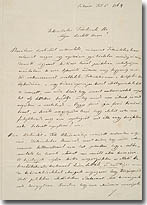 The
pilgrims of Kashgar choose from the three potential routes the one they
considered the safest, leading along the western border of the Turkmen desert,
parallel with the coast of the Caspian Sea, then turning to East, and going
through Khiva to Bokhara. Started from the station of Karatepe (Qaratappah) they
left the territory of Iran, and by bypassing the promontory separating the open
water of the Caspian Sea from the Iranian coastline they headed towards Gümüstepe (Gomishan).
Crossing the Atrek river, Vámbéry made a long desert road, either on horse- or
on camelback, or by foot, as a member of the caravan of an estimated 40 members
and 80 camels.
The
pilgrims of Kashgar choose from the three potential routes the one they
considered the safest, leading along the western border of the Turkmen desert,
parallel with the coast of the Caspian Sea, then turning to East, and going
through Khiva to Bokhara. Started from the station of Karatepe (Qaratappah) they
left the territory of Iran, and by bypassing the promontory separating the open
water of the Caspian Sea from the Iranian coastline they headed towards Gümüstepe (Gomishan).
Crossing the Atrek river, Vámbéry made a long desert road, either on horse- or
on camelback, or by foot, as a member of the caravan of an estimated 40 members
and 80 camels.
The Turkmen desert, and especially the Central Asian khanates were
extremely dangerous for non-Muslim, European travelers. The dangers menacing the
travelers in these very closed Sunni communities which, on the border of the
Russian and English spheres of influence, loked with an increased suspicion on
all strangers, and seeing a spy in every European, are well attested by the
tragic fate of the two travelers arriving here a couple of years before Vámbéry,
and mentioned in his memoirs. In Bokhara the British diplomat and officer Charles Stoddart (1806–1842)
was put in prison in 1838 with the charge of espionage on the command of Emir
Nasrullah, and beheaded in 1842 together with the British traveler Arthur Conolly
(1807–1842) coming to Bokhara to request his release. Nevertheless, the
missionarian Joseph Wolff (1795–1862)
coming to find them a year later could return alive from Bokhara. The French
officer in Iranian service Henri Blocqueville de
Couillebeuf was kidnapped by the Turkmens, but he was finally released for a
ransom of 12,000 gold.
13
The authentic performance of Vámbéry was so difficult not only
because his appearance, skin color and facial features, which looked out of
place in this environment. His role-playing required permanent presence of mind
and divided attention, a constant control of his speech and gestures, and it is
hardly surprising that, in spite of his best efforts, this was not always
perfect.
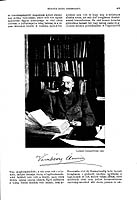 Vámbéry
successfully acted the role of the mendicant dervish, but he reported that some
people nevertheless discovered, or at least suspected his being a European (“frengi”).
Already at an early stage of his journey, at the station of Demarend he assumed
some Persians to be aware of his European identity. His role had a number of
separate layers. The group of pilgrims got to know him as an Ottoman efendi, and
accepted him in their confidence as “the secretary of the Sultan” on the
recommendation of the Turkish ambassador in Tehran, so they could have no doubts
as concerning his dervish incognito. However, they could surely not imagine that
Reshid efendi is not even Muslim. A much-traveled Afghan member of the caravan,
as well as the leader (kervanbashi) of the caravan passing through the desert
suspected him to be a European spy, and the latter, fearing the wrath of the
Khan of Khiva, did not want to take him with the group.
14
Vámbéry
successfully acted the role of the mendicant dervish, but he reported that some
people nevertheless discovered, or at least suspected his being a European (“frengi”).
Already at an early stage of his journey, at the station of Demarend he assumed
some Persians to be aware of his European identity. His role had a number of
separate layers. The group of pilgrims got to know him as an Ottoman efendi, and
accepted him in their confidence as “the secretary of the Sultan” on the
recommendation of the Turkish ambassador in Tehran, so they could have no doubts
as concerning his dervish incognito. However, they could surely not imagine that
Reshid efendi is not even Muslim. A much-traveled Afghan member of the caravan,
as well as the leader (kervanbashi) of the caravan passing through the desert
suspected him to be a European spy, and the latter, fearing the wrath of the
Khan of Khiva, did not want to take him with the group.
14
Unfortunately, his incognito significantly impeded him in his
scientific objectives. Because of the suspicion surrounding him, he could make
notes only in secret and on rare occasions. In addition, it would have been
incompatible with his role to buy a larger amount, or non-religious manuscripts
in the bazaar of Bokhara. This was anyway made impossible by the lack of money,
a companion of his ascetic lifestyle. The direct memories of his journey include
the largest part of his Eastern Turkic manuscripts – Vámbéry mentions 18 such
works
15
–,
and the small, litographed Quran, now in the Oriental Collection of the
Hungarian Academy of Sciences, whose role is remembered by a barely visible note
by its owner on the first page: “...dervish incognito [...] hanging around my
neck in a Persian flat bag.” And: “This Quran, purchased in Tehran, hung
around my neck all along my Central Asian journey in this same green bag, and
was with me day and night.”
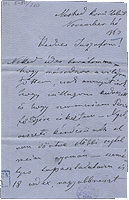 The vicissitudes of the weather – rainfall, in the desert the grueling
alternation of daytime heat and cold nights, sand storms, water shortage –, as
well as the insects and vermins were a great trial to Vámbéry, as during the
three-week desert march he arrived from the Atrek river to Khiva. On 3 June 1863
he entered through the gates of the city. Familiar with the Istanbul conditions,
and up to date in the relationships of the elite, Reshid efendi successfully won
the confidence of Sükrullah, the leading dignity of the Khan, and through him he
made it to the Khan’s court. The name of Istanbul, also due to the Sultan
who was the Caliph of all the Sunnis, had a high prestige among the Central
Asian turks, commanding respect and appreciation, and also a conveniently remote
city, which in the imagination of Reshid efendi’s hosts intertwined with
mythical beliefs. The respect and ignorance surrounding the imperial city played
to a non-negligible extent to Vámbéry’s benefit, when he presented himself as
coming from there. As he wrote: “His Majesty the Emperor of Turkey was here
imagined as a Muslim wearing an at least fifty haberdasher long turban, whose
beard hangs down under his chest, and whose clothes cover his toes; and whoever
would dare to say that the Sultan has his hair cut à la Fiesco and his clothes
are made by Dusetoye in Paris, would certainly risk his life.”
16
The vicissitudes of the weather – rainfall, in the desert the grueling
alternation of daytime heat and cold nights, sand storms, water shortage –, as
well as the insects and vermins were a great trial to Vámbéry, as during the
three-week desert march he arrived from the Atrek river to Khiva. On 3 June 1863
he entered through the gates of the city. Familiar with the Istanbul conditions,
and up to date in the relationships of the elite, Reshid efendi successfully won
the confidence of Sükrullah, the leading dignity of the Khan, and through him he
made it to the Khan’s court. The name of Istanbul, also due to the Sultan
who was the Caliph of all the Sunnis, had a high prestige among the Central
Asian turks, commanding respect and appreciation, and also a conveniently remote
city, which in the imagination of Reshid efendi’s hosts intertwined with
mythical beliefs. The respect and ignorance surrounding the imperial city played
to a non-negligible extent to Vámbéry’s benefit, when he presented himself as
coming from there. As he wrote: “His Majesty the Emperor of Turkey was here
imagined as a Muslim wearing an at least fifty haberdasher long turban, whose
beard hangs down under his chest, and whose clothes cover his toes; and whoever
would dare to say that the Sultan has his hair cut à la Fiesco and his clothes
are made by Dusetoye in Paris, would certainly risk his life.”
16
Vámbéry spent one month in the territory of the Khanate of Khiva,
but the larger part of this time outside of the city itself. He succintly
remembers the 18-day long excursion he made in the companionship of Sükrullah to
Kungrat, there on boat along the Oxus, and back on land.
17
The group of pilgrims left Khiva on 27 June 1863. The relatively short section
leading from here to Bokhara had no little danger in store for the members of
the caravan, the scorching sand storms and dehydration nearly proved fatal for
Vámbéry. In Bokhara the leading dignity of the Emir, Rahmet Beg tried to test
Vámbéry’s credibility, but he successfully went through these exams. He provided
a detailed account not only about the town, but also on the Emir, Muzaffaraddin
bin Nasrallah
(1860–1886) and his court.
18
18 days later he said farewell to the members of the group heading to Khokand,
and he went to Samarkand with a smaller group of only two wagons. There he
visited not only Timur Lenk’s turbe and mosque, but it was a must to him as a
pilgrim to visit several shrines, too. The local Emir personally received him.
Vámbéry then returned to the northeastern areas of Iran through the city of
Karsi in the Emirate of Bokhara, and the western borderland of today’s
Afghanistan.
In Samarkand he said farewell to the other pilgrims, and by joining
another group he took the road to home. They went through Karsi to the Oxus, and
crossed it at Kerki (today Atamurat in Eastern Turkmenistan). Among his new
companions he got in closer acquaintance with a young “mullah”, who first joined
the group in Kungrat, and later became a faithful disciple of Vámbéry. His
devoted and sincere readiness won Vámbéry’s sympathy, and by giving up his
original goal, Mecca – and surely also by overcoming his shock over the change
of role of his master – he eventually followed Vámbéry to Pest. They proceeded
to the south in the western part of Afghanistan, through the Khanate of Maymana
to Herat, which just a few months ago was still under siege, and bore the traces
of the battles. On the way leading to the Iranian border, the increasingly cold
night, the ransoms of the Afghans and the raids of the Turkmen Tekke tribe were
a constant threat. The traveler, having exhausted his last financial resources,
turned to the local ruler, the young Muhammed Yakub Khan
(1849-1923) to ask for his support in reaching Mashad. Due to his stranger
features, the young Khan was suspicious of Vámbéry, of whom they could not prove
to be an Englishman, but he could not get rid of the annoyances. A good example
of the above mentioned complexity of Vámbéry’s incognito is, that the smallest
self-forgetfulness was enough to being unveiled. From the later recollections of
Warburon we know, that Muhammad Yakub noted the custom, unknown in the East,
that Vámbéry involuntarily beat the rhythm with his foot when the military band
marched in the Khan’s court.
19
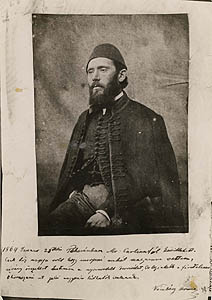 The
closer the possibility of returning home was, the more the homesickness and
tiredness fell on Vámbéry. He had to stay long in Herat, until finally he could
join a caravan to Mashad. He left Herat on 10 November 1863, and twelve days
later arrived in Mashad. In this last section of his journey he suffered a lot
from the gritty cold November nights, so reach the Persian city was a great
relief for the exhausted discoverer, who expressed this feeling in his letter
written from Mashad.
20 He rested for two months in Tehran, and on 28 March 1864 he left
the Persian capital, to return through Tabriz and Trapezunt to Istanbul.
The
closer the possibility of returning home was, the more the homesickness and
tiredness fell on Vámbéry. He had to stay long in Herat, until finally he could
join a caravan to Mashad. He left Herat on 10 November 1863, and twelve days
later arrived in Mashad. In this last section of his journey he suffered a lot
from the gritty cold November nights, so reach the Persian city was a great
relief for the exhausted discoverer, who expressed this feeling in his letter
written from Mashad.
20 He rested for two months in Tehran, and on 28 March 1864 he left
the Persian capital, to return through Tabriz and Trapezunt to Istanbul.
His travel experiences enriched him with unique knowledge covering
several fields (linguistics, history, ethnography, geography), and basically
determined his further career.
His successful return first to Tehran and then to Istanbul
attracted great interest, especially among the representatives of the European
states. In Tehran he informed Nasreddin Shah at an audience about his
experiences. The British ambassador Alison asked him for a report, and he also
gave him letters of recommendations to Lord Palmerstone, Lord Strangford, Sir
Justin Sheil and Sir H. Rawlinson. His discoveries also elicited the curiosity
of the Russian diplomacy, but Vámbéry, staying true to his political views,
refused the invitation of Nikolai Girsh, Russian ambassador to Tehran.
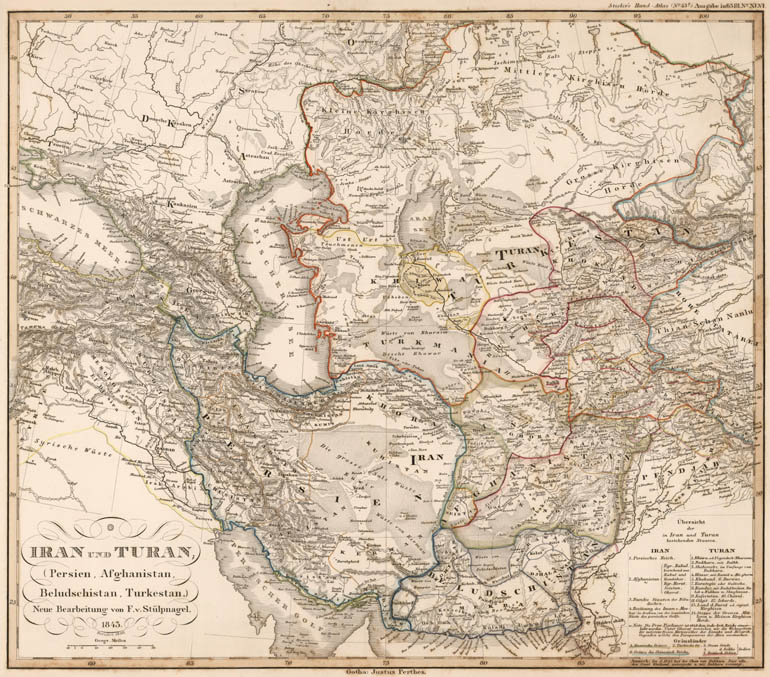
Iran and Turan (Persia and Central Asia). Map
by Stieler, 1850 (full map here, 11 MB)
